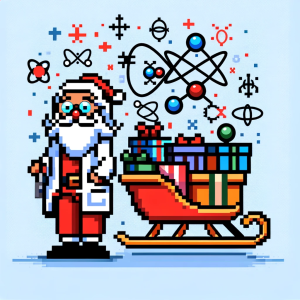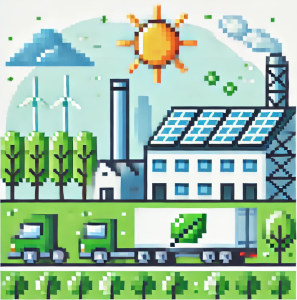
How Santa’s Route Solved a Giant Puzzle
Have you ever wondered how Santa manages to deliver presents to millions of children in just one night? It turns out, solving this logistical marvel is more than just Christmas magic—it’s a complex mathematical puzzle known as the Traveling Salesperson Problem (TSP). Researchers recently put Santa’s efficiency to the test with a holiday-themed challenge: Could an algorithm plan Santa’s route through 1.4 million Finnish households in under one hour? The results could revolutionize how we approach everything from package delivery to environmental sustainability.
The Problem: A Puzzle Beyond Santa’s Workshop
The Traveling Salesperson Problem asks a deceptively simple question: What’s the shortest route connecting a series of points while visiting each one exactly once? Despite its simplicity, this question lies at the heart of logistics, from optimizing truck routes to designing microchips. It’s a famously tough nut to crack, especially for large-scale scenarios like Santa’s route.
Why is it so hard? The challenge grows exponentially with each additional stop. For Santa, this meant finding a path through 1.4 million Finnish households—far beyond the scale of what most algorithms can handle.
To make it even tougher, the competition introduced several variations:
- Closed Loop: Santa starts and ends at the North Pole.
- Open Loop: No return trip required.
- Fixed Start: Santa leaves from a specific location, like his workshop in Rovaniemi.
- K-TSP: Multiple helpers share the workload.
The Solutions: Smart Algorithms at Work
Participants submitted algorithms designed to tackle Santa’s route. While only three solutions passed the rigorous tests, each offered a unique perspective on solving large-scale logistical challenges. Here’s how they did it:
1. Local Search Magic
All submissions relied on a technique called local search. Imagine you’re navigating a city and trying out small route changes to see if they shorten your trip. These incremental tweaks, guided by mathematical rules, can lead to remarkably efficient solutions. For Santa, the “k-opt” strategy, which adjusts up to five connections at a time, emerged as the standout approach.
2. Divide and Conquer
When faced with millions of stops, breaking the problem into smaller pieces can save the day. Some algorithms divided Finland into clusters, solved each region individually, and then merged the results. While this approach sacrificed some precision, it dramatically sped up calculations—perfect for real-time logistics like food delivery.
3. Parallel Processing: Speed in Numbers
One submission took advantage of modern computing by running parts of the algorithm simultaneously on multiple processors. This parallelization shaved critical minutes off the clock, hinting at exciting possibilities for future applications.
Why This Matters: Beyond the North Pole
What can Santa’s challenge teach us about the world? Plenty! Here are just a few ways these insights could transform our everyday lives:
1. Greener Deliveries
Reducing the total distance traveled by delivery trucks could cut fuel consumption and lower CO2 emissions. Imagine a future where your online orders arrive faster and more sustainably, thanks to smarter routing algorithms.
2. Pandemic-Era Logistics
The COVID-19 pandemic strained supply chains worldwide. Optimized routing could ensure critical supplies reach hospitals, supermarkets, and homes more efficiently during emergencies.
3. Everyday Convenience
From planning road trips to streamlining public transportation, the principles behind Santa’s route could make life easier for everyone. Who wouldn’t love a traffic-free commute?
The Big Picture: Unsolved Mysteries and Future Potential
While Santa’s helpers achieved impressive results, their work leaves room for improvement. Challenges like balancing workloads between helpers or scaling solutions to billions of stops remain open questions. Future research could harness advances in artificial intelligence, quantum computing, or crowdsourced data to push these limits even further.
Imagine:
- Drones delivering packages with pinpoint accuracy.
- Emergency responders navigating disaster zones faster.
- Entire cities reimagined with traffic-free streets.
The possibilities are as limitless as the night sky on Christmas Eve.
Let’s Explore Together
What do you think about the science behind Santa’s journey? Could these algorithms improve your life, or do they raise new questions about privacy and automation? Join the conversation in the comments or on social media!
Here are some ideas to get us started:
- How could smarter routing change your daily commute or holiday travels?
- What other large-scale problems could benefit from these techniques?
- Do you see any downsides to relying on algorithms for decisions like these?
Santa’s annual journey may seem like magic, but it’s also a reminder of how science and creativity come together to solve the world’s biggest puzzles. Whether you’re tracking gifts on Christmas Eve or imagining the future of logistics, one thing is clear: The quest for optimization is a gift that keeps on giving.
Unlock Science Secrets
Discover revolutionary research and innovative discoveries with ‘This Week in Science’! Designed for educators and science lovers, our free weekly newsletter offers insights that can transform your approach to science. Sign up now and deepen your understanding and passion for science. If you liked this blog, please share it! Your referrals help This Week in Science reach new readers.



